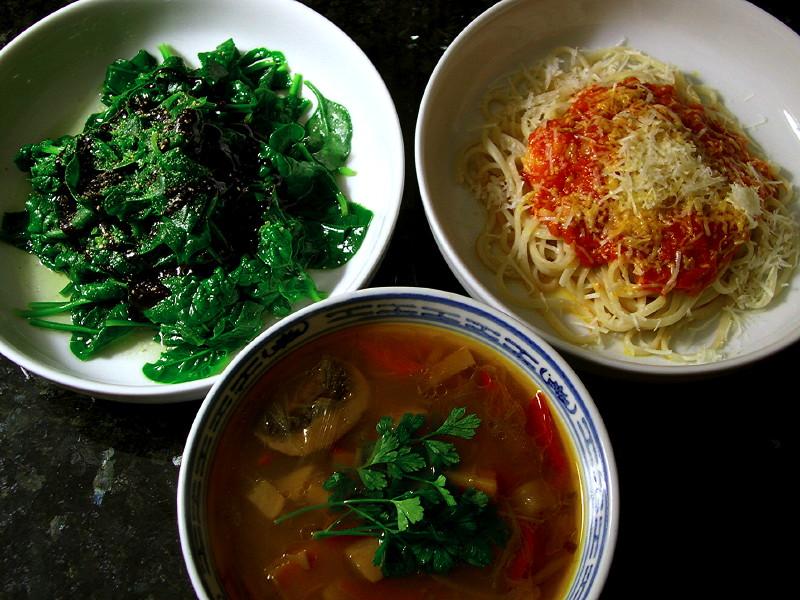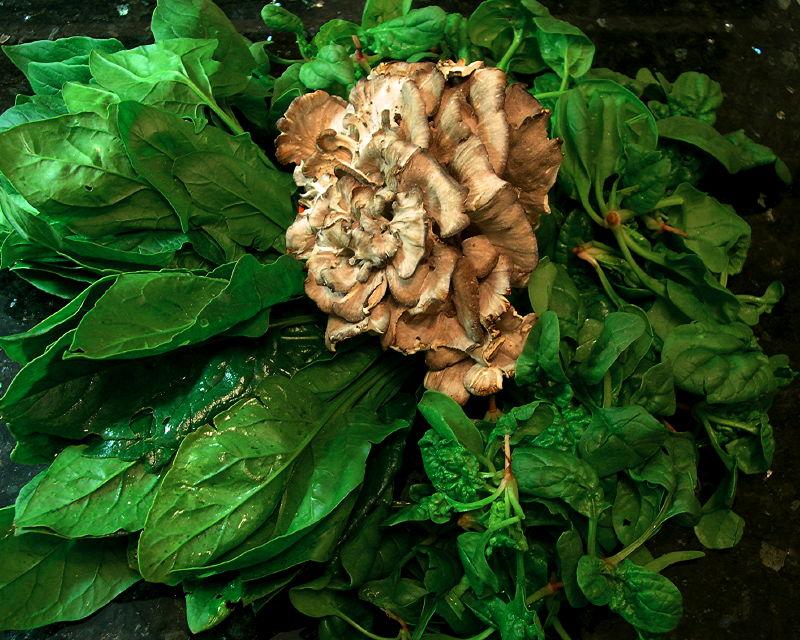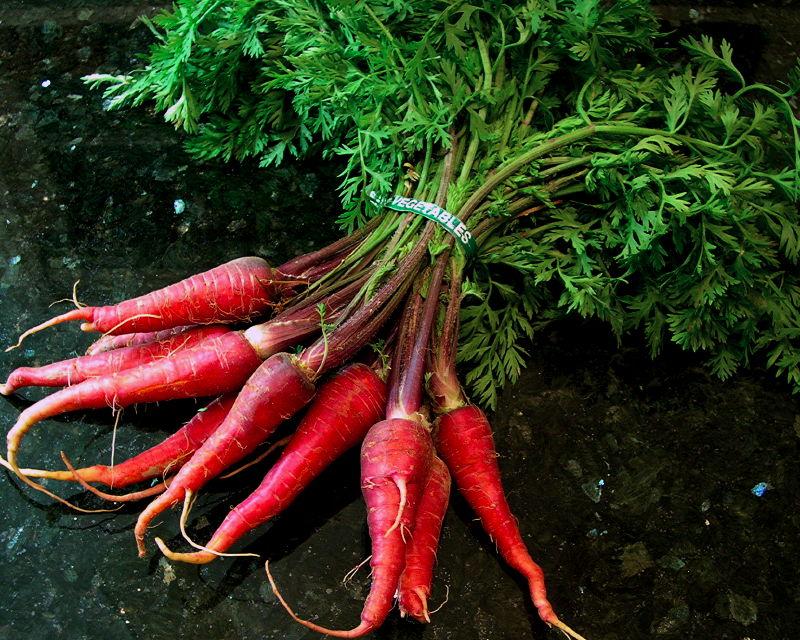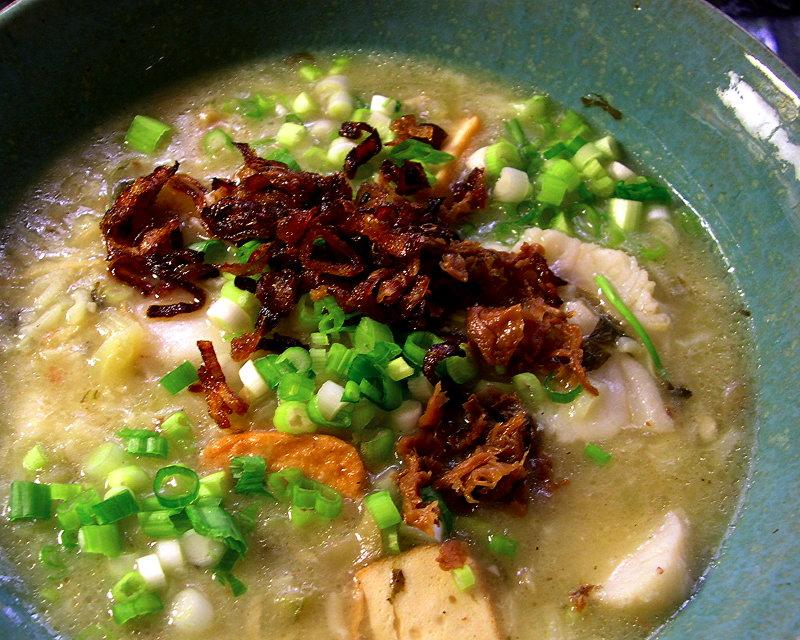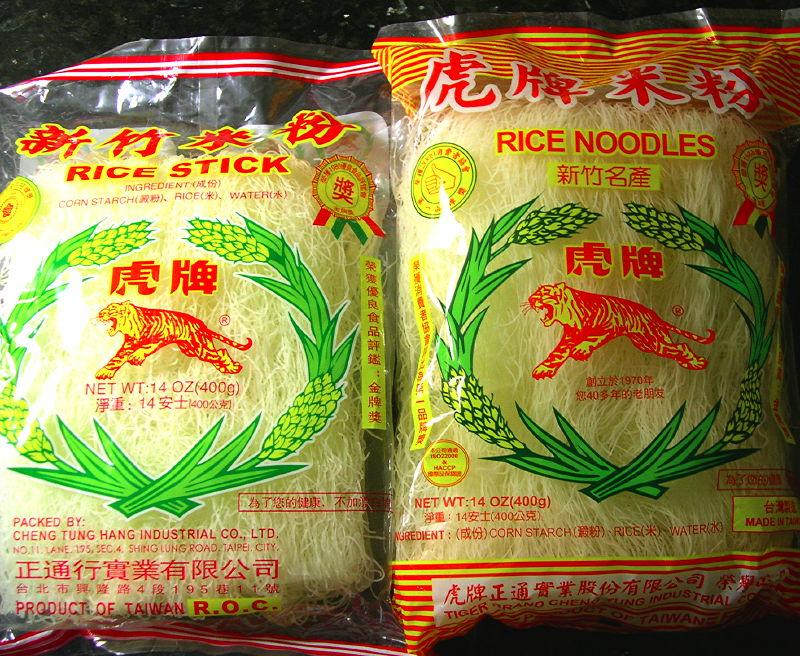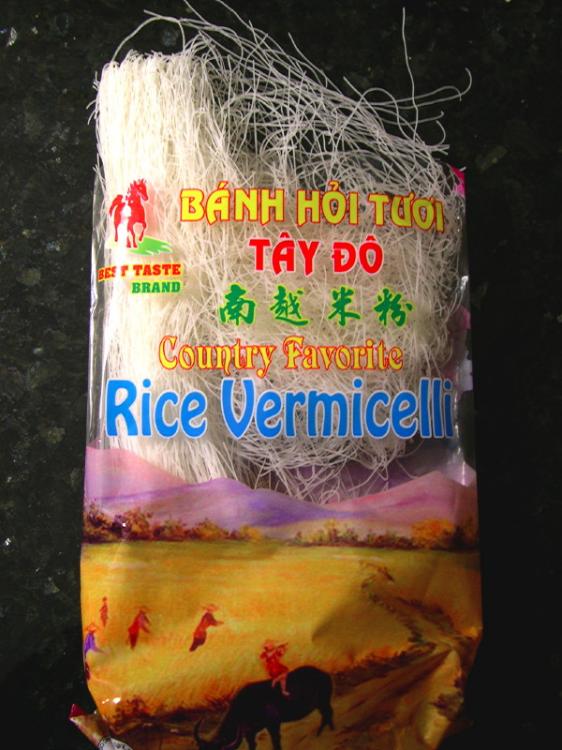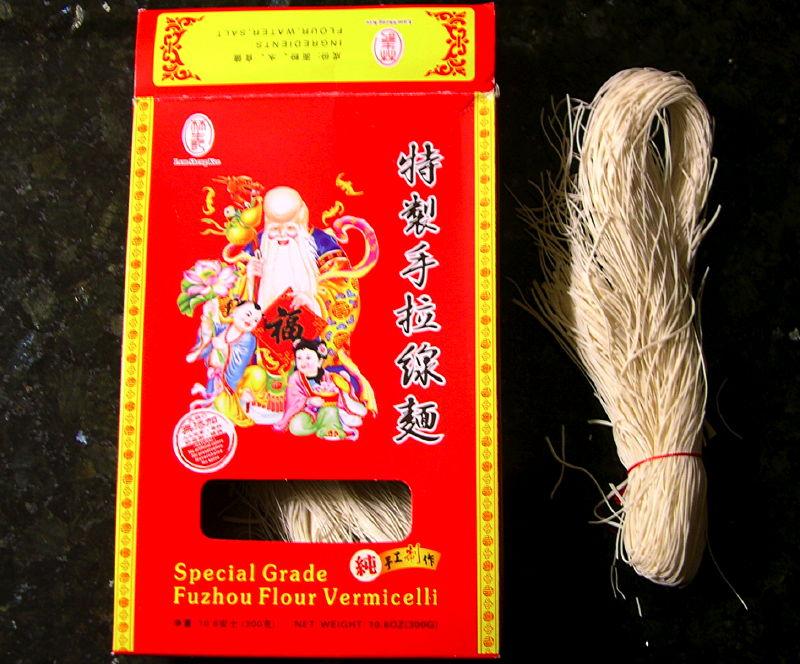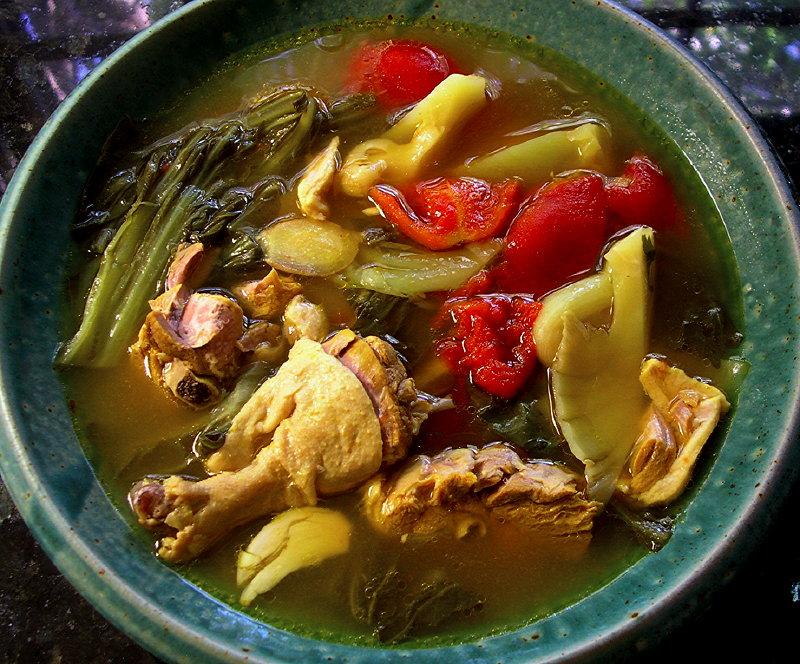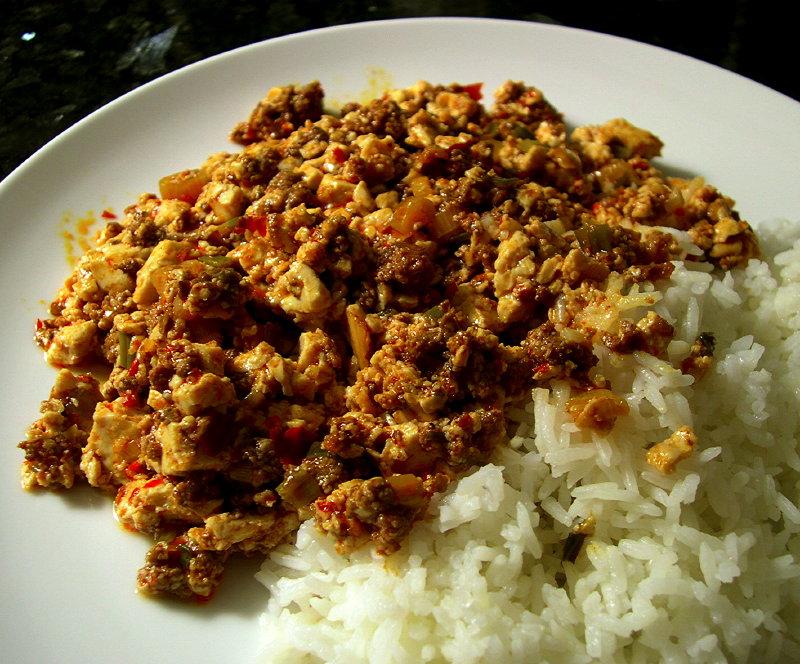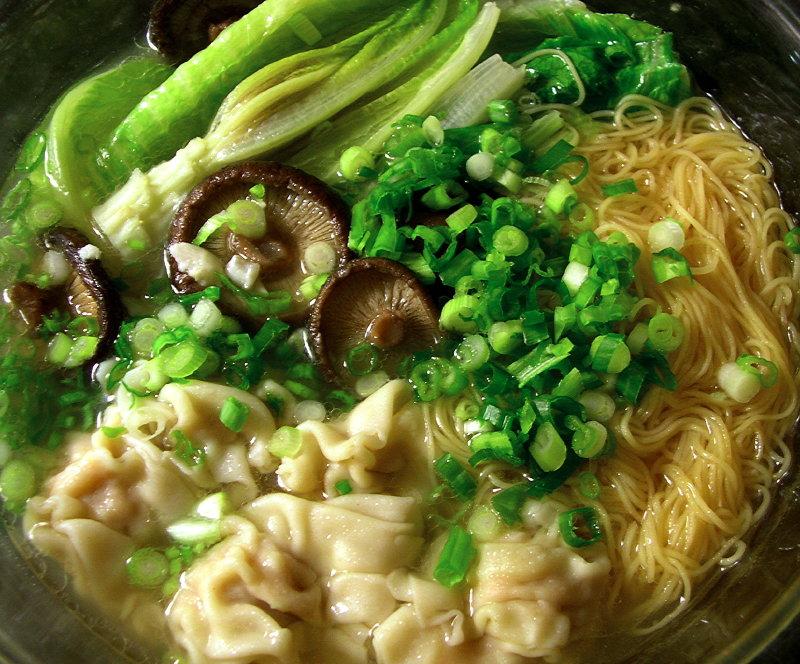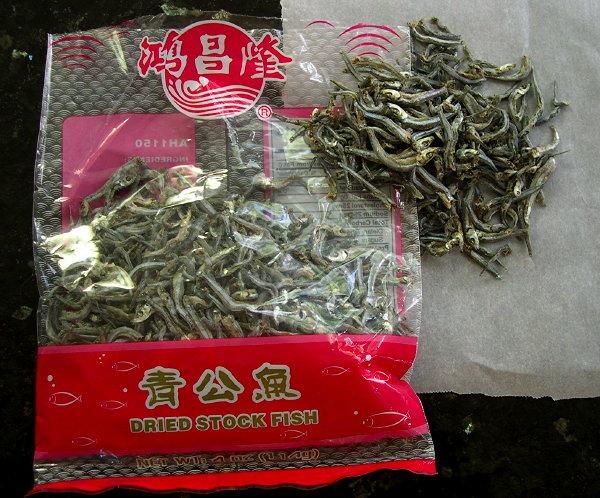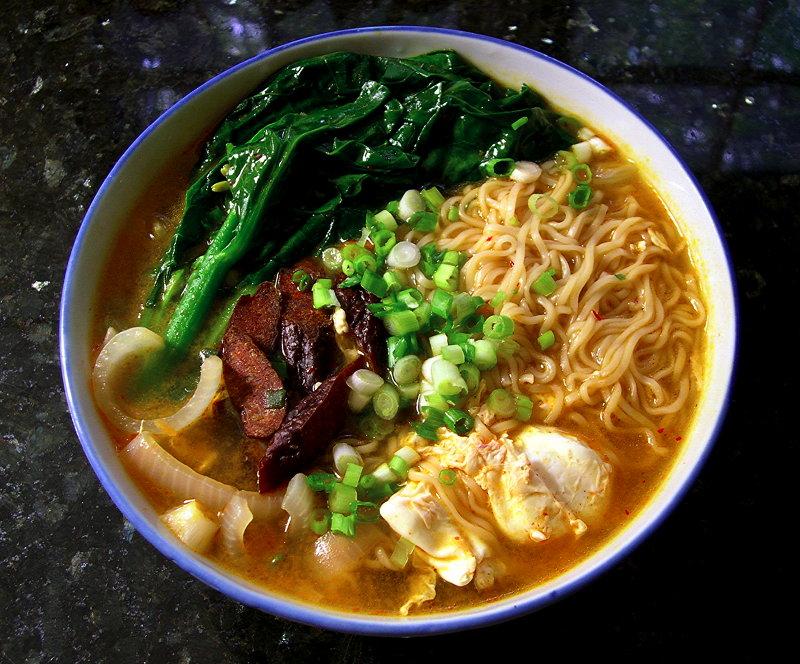-
Posts
3,810 -
Joined
-
Last visited
Content Type
Profiles
Forums
Store
Help Articles
Everything posted by huiray
-
• Fresh linguine w/ Hazan-style tomato sauce, from fresh ripe tomatoes. Pecorino Romano. • Trimmed baby spinach, blanched in oiled hot water & dressed w/ oyster sauce & ground white pepper. • Vegetable soup.¶ ¶ Olive oil, shallots, smashed garlic, cubed celeriac root, water, sea salt, cubed turnips, sliced old red carrots, chopped ripe tomatoes, sliced "normal" mushrooms, sliced red Italian sweet peppers. Simmered for about 6-8 hours. Bowl of it dressed w/ fresh parsley.
-
Dunno. 7th graders are on the cusp of striving to be "too cool for words" (of course there will be exceptions) especially when they are quite aware of being videotaped and being "on air" and their reactions may not be exactly spontaneous. :-)
-
BRFM: Maitake mushroom (half of a large frond), red carrots, young daikon, loose baby spinach, bundled spinach leaves, small broccoli florets, tomatoes. Goose the Market: Merguez sausages, Dodge City salami, Taleggio (Ciresa) cheese, Shagbark Oatmeal cookie (from H2O Sushi). The Fresh Market: Wild American (Georgia) shrimp, large croissants.
-
I hope you would have sampled some of the other dishes. :-) As Kerry Beal commented on, he basically didn't eat anything until dessert came and then the madeleines essentially constituted what he ate at Daniel! :-D
-
Chelseabun, have a look at these articles: http://www.justhungry.com/vegetarian-dashi-japanese-stock http://www.justhungry.com/2003/11/japanese_basics.html http://www.justhungry.com/2007/01/seaweed_hijiki_wakame_kombu_no.html From the second linked article above you can also easily cross over to this: http://www.justhungry.com/handbook/cooking-courses/japanese-cooking-101-lesson-1-its-all-about-dashi and from that one to this: http://www.justhungry.com/handbook/cooking-courses/japanese-cooking-101-lesson-1a-making-miso-soup-clear-soup For myself, miso soup is not miso soup without wakame. Is there a decent Japanese restaurant near you where you could sample some miso soup? BTW, from the same site here's a primer on miso: http://www.justhungry.com/handbook/just-hungry-reference-handbooks/japanese-miso-primer The quality and variety of the miso affects the characteristics of the miso soup you make. I myself never make it with akamiso. I almost always use shiromiso. Just personal preferences. However, akamiso is nice in some heartier dishes like some forms of nabe or braises or stews and whatnot (sometimes mixed w/ shiromiso in varying proportions depending on what is being made). P.s. Konbu from Japan Centre, London. This answer set includes the konbu sheets as well as packs of already-made konbu-only dashi stock. P.p.s. I myself would not use glasswort (samphire) to make miso soup, not for my tastes anyway. I'm sure it would make a nice stock but I'd call the soups made with it by other names.
-
Rice congee w/ fish. Peanut oil, finely sliced ginger, chopped smashed garlic; a packet of preserved mustard stems (榨菜), sliced pickled mustard greens (酸菜); “fish tofu”, sliced up; Redmond salt; water, fish sauce [Red Boat], simmer; raw rice (Thai hom mali; water:rice approx 10:1); simmer; lots of freshly ground white pepper; Cod fillet, sliced up into thickish pieces (pre-marinated in Shaohsing wine, corn oil, jozo mirin [Morita], freshly ground white pepper). Eaten w/ chopped scallions, deep-fried shallots, Tianjin preserved vegetable (冬菜).
-
http://www.nytimes.com/2014/10/12/magazine/fine-dining-for-second-graders.html Heh.
-
http://www.thewasabistore.com/wasabi-plant-starts/
-
Here's a pic of a type of rice noodle that works well with a simple soak in hot/was-boiling water. They're the same brand, really, just bought at different times and have slightly different packagings. Again, they don't soften properly if not allowed to soak by themselves with sufficient hot water in a bowl. Another brand which I like and which performs similarly is this one, which I do not have in my pantry at the moment. Here's a pic of those very thin "rice vermicelli" noodles I thought might work in that one-small-pot composition: Here's a pic of those very thin Fuzhou-type wheat noodles I talked about: These are brittle. They will break into pieces if one tried to bend them into a small bowl. You could have them "in the same bag" as the rest of the stuff in a glass tub then fold them into the tub as you add the hot/boiling water.
-
I still don't know what "spread organically" means. Regarding substitutions, comments, etc: http://forums.egullet.org/topic/149466-what-is-most-important-in-a-cookbook/?p=1986537#entry1986537 The recipe with the cured eggs reads pretty "densely" to me. The butterscotch pie one reads better. I have to agree with Crepes' comment above - the ingredients seem esoteric (haha, I should speak) and the assembly pretty involved. If, as you say, you are aiming at the advanced cook then be conscious that you will not have a wide readership. Perhaps the academic press you are angling for is indeed the proper publisher. BTW, out of curiosity - what is it about cattails and cattail ash that makes it remarkable, or makes it the desired ingredient in a dish, over and beyond anything else?
-
There are some rice noodles that are nicely cooked/softened (at least to my satisfaction) when soaked in hot water (from boiling, poured from the kettle) in some bowl or container. They tend to be the skinnier ones, especially those with a certain translucency and pliability to them. It's hard to describe - let me take a picture of one of the types I have on hand a little later. The "broader" or thicker ones typically used for pho, for example, or even skinnier ones with a certain denseness or opaqueness to them will NOT soften properly with just a soak in hot water and all will then need to be cooked in boiling water. In the case of the rice noodles that perform satisfactorily, they also need to be soaked by themselves - the stuff from packages of them alone, that is, not the ones that have been treated/parboiled already in those "instant noodles packages" that are the object of the "getting away from" exercise. Having a whole bunch of stuff in the same SMALL container with a single pour of hot water will simply suck so much heat away from the noodles that they simply will not soften enough. There are two noodles that come to mind off the top of my head that may work in your circumstances, with that small container with all the other stuff as well in it. One is a really fine rice noodle, labeled (in English) as rice vermicelli - I'll take a pic of the one I have on hand in a bit - and the other would be the fine/very thin form of Fuzhou WHEAT noodles (a really skinny form of misua). Both would, however, also release a lot of starch & some milkiness into the whole shebang as they soak in the (rapidly cooling) hot water.
-
I had to take a look again at what "Ivan Ramen" was, even though I knew about it in a general sense - because of the dried fishes (sardines? or anchovies?) you used in that dashi. Anna, do you like wonton soup? If you do, be advised that the good ones use "stock fish" in making the broth.
-
Ann_T, aw shucks. Thanks. Those chicken livers of yours look very good. Recipe, please?
-
Not that I know of. Just use a soup-type spoon whether round or oval (=Tablespoon). Or a Chinese-type spoon, the ones with an elliptical/oval flat-bottomed "bowl" and a handle at an angle to the bowl. If you are a giant and your mouth is of the expected dimensions then, hey, a serving spoon would work better (and the serving of salad would be commensurately much larger, of course) If you are a child and have a small mouth, then why, a teaspoon might be called for. The standard set of implements at a Korean meal usually include a pair of metal chopsticks and a fairly long-handled metal spoon - maybe you might like that long-handled type. I.e. whatever works best for you.
-
-
Chopped salad? If you are referring to what I am thinking about - then, SPOON, of course. Fork alone as a poor second choice. Fork and spoon, if the serving bowl allows that. The people who look askance at me as I spoon the salad to my mouth can go f*ck themselves.** (Just as folks who gasp at my eating curry with rice on a plate with fork and spoon need to get out more in the world)
-
It's a concentrated paste of ripe tomatoes dried on tilted boards in the sun - Sicilian. Yes? http://www.formaggiokitchen.com/shop/product_info.php?products_id=1430 Use anywhere one would use tomato paste, but as something that is more intense? Smithy's suggestions make sense, except I might slurry it with some good olive oil first rather than applying it directly to pasta, as an example. I think it would very well in ragus and bolognese-type sauces. I myself might like to try it (off the top of my head) in a "sauce" made with broccoli rabe, artichoke hearts, capicola, red chilli flakes, shallots maybe...i.e. in place of chopped-up sun-dried tomatoes.
-
Pork & shrimp wontons [Prime Food] w/ skinny wonton noodles, blanched romaine lettuce, chopped scallions & a soup from chicken stock simmered w/ small shiitake mushrooms, smashed garlic and a handful of "stock fish" (a kind of small dried anchovies; 青公魚) (see picture). The mushrooms were retrieved and added to the bowl of noodles, the stock filtered.
-
Those maitake mushrooms look great. "front yard" ? I suppose those beans were too old to cook as whole beans? Would you cook these whole (and others) - i.e. other than the usual "green beans" - after topping-and-tailing/destringing when younger/tender? (I do. :-) )
-
When I was growing up one of my favorite dishes when eating at Indian (Tamilian/Keralan) or Mamak shops was kari telur ikan (fish egg curry), maybe something that looked like this although usually what I got were "unruptured" eggs. Or maybe a (shared) order of something like this. If I had pei tan/dan with preserved ginger slices or rice congee with a sliced salted ovum they would be from ducks (female, of course). In the milieu I grew up in, a wide enough range of eggs were commonly eaten such that one normally referred to what kind of egg one was talking about - "kai/gai tan/dan" (chicken eggs/hen eggs), "ngap tan/dan" (duck eggs), "yuu/jyu tan/dan" (fish eggs) and so on - in the normal course of conversation in a matter-of-fact manner.
-
"Instant Noodles Artificial Pork-Ribs Flavor" (紅燒排骨麵) [Dragonfly brand] gussied up with: the leftover marinating liquid of a bowl of kkakdugi [5,000 Years Food, Inc.] (cubed radish kimchi) I had as part of dinner the night before; couple of sliced Debreziner sausages that had sort-of dried out and which I rehydrated by simmering in water, then sliced up and simmered in the water that was going to be the "soup" for the dish; sliced half of a yellow onion; couple of green-shelled farm eggs poached in situ; trimmed kai-lan. (The soup, seasoning, dried vegetables packages plus the noodle block went in, of course!) Chopped scallions.
-
Interesting about the rice cracker holding up best. It is of note to me that the batter for the kueh pie tee cups uses rice flour - perhaps at another time, if one has the mold in hand, one could experiment with making thicker cups (thicker batter? more rice flour?) and see how those perform with leaving wet stuff in them for hours. I buy those Sesmark rice thins myself from time to time and enjoy them thoroughly. I seem to remember that I've seen them in two sizes (i.e. a bigger one...?) but I may be mistaken.
-
I don't have experience with freeze-drying trays and trays of foodstuff in the tray-type freeze dryers - but in my previous life where I used the manifold-type freeze dryers if there was substantial water in the oil after each run it meant the cooling cylinder was just not trapping water efficiently enough. Vacuum that was not low enough would also tend to do this. Water in the pump oil also tended to hurt the pump and reduce the vacuum pull of the pump...
-
Interesting article, thanks. Glad I'm not the only one who "prefers" leftover potatoes, heh. :-)
-
Well, gkas, feel free to NOT watch the show. :-)



